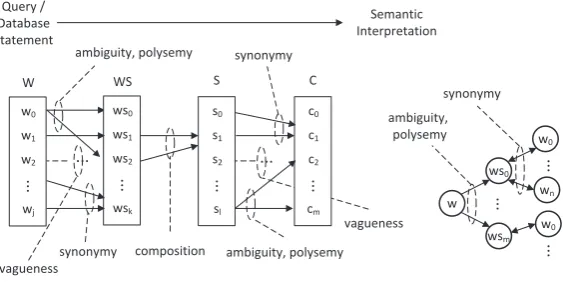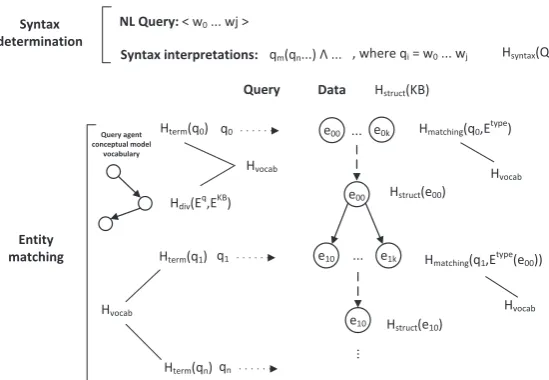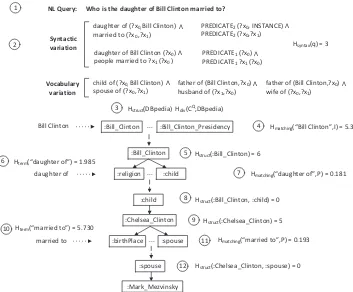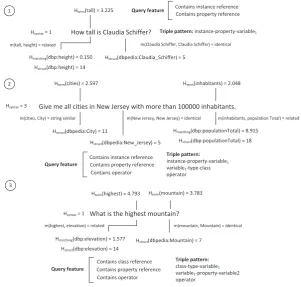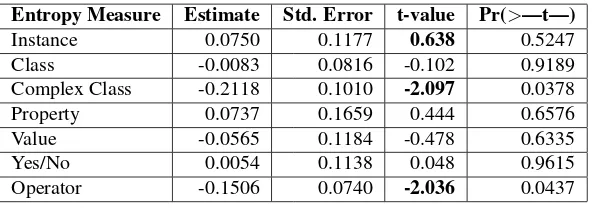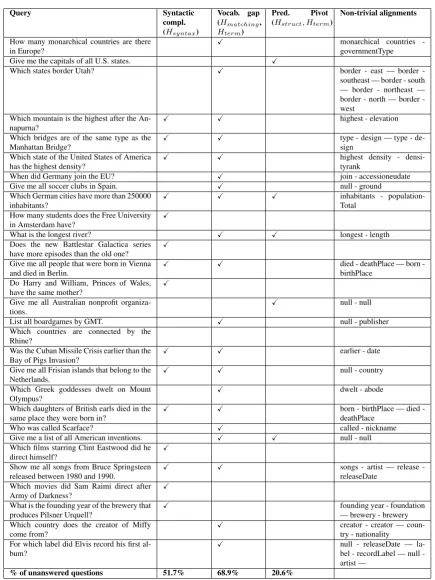How hard is this query? Measuring the Semantic Complexity of
Schema-agnostic Queries
Andr´e Freitas1, Juliano Efson Sales2, Siegfried Handschuh1, Edward Curry2
1Department of Computer Science and Mathematics
University of Passau
2Insight Centre for Data Analytics
National University of Ireland, Galway 1firstname.lastname@uni-passau.de 2firstname.lastname@insight-centre.org
March 25, 2015
Abstract
The growing size, heterogeneity and complexity of databases demand the creation of strategies to facilitate users and systems to consume data. Ideally, query mechanisms should beschema-agnostic, i.e. they should be able to match user queries in their own vocabulary and syntax to the data, ab-stracting data consumers from the representation of the data. This work provides an information-theoretical framework to evaluate the semantic complexity involved in the query-database commu-nication, under a schema-agnostic query scenario. Different entropy measures are introduced to quantify the semantic phenomena involved in the user-database communication, including structural complexity, ambiguity, synonymy and vagueness. The entropy measures are validated using natural language queries over Semantic Web databases. The analysis of the semantic complexity is used to improve the understanding of the core semantic dimensions present at the query-data matching process, allowing the improvement of the design of schema-agnostic query mechanisms and defining measures which can be used to assess the semantic uncertainty or difficulty behind a schema-agnostic querying task.
Semantic Complexity, Entropy, Schema-agnostic Queries, Database Queries, Databases
1
Introduction
The growing data availability on Big Data environments demands the creation of strategies to facilitate the interaction between data consumers and databases. As the number of available data sources grows and schemas increase in size and complexity, the effort associated with matching aninformation needto a database schema, intrinsic to the creation of structured queries such as SPARQL and SQL, becomes prohibitive. Ideally, data consumers, being them humans or intelligent agents, should be able to be abstracted from the representation of the data by using aschema-agnostic query mechanism[6].
However, structured queries are still the primary way to interact with databases. Despite the evolution of natural language interfaces (NLIs), and the empirical evaluation behind different NLI approaches, rel-atively little attention is given to the analysis of the semantic phenomena behind the user-database com-munication (UDC). The construction of semantic models for databases brings the potential of improving UDC and the design of more principled schema-agnostic query mechanisms.
In this work information theoretic models are used to define measures ofsemantic complexity for
schema-agnostic queries. The measures of semantic complexity are used to quantify the role of core se-mantic phenomena such asambiguity,synonymyandmatching complexityin thesemantic interpretation
of schema-agnostic queries. The contributions of this paper are: (i) to provide a principled and compre-hensive analysis of existing semantic measures of semantic complexity in the UDC context, (ii) to vali-date these measures over a realistic query scenario based on natural language queries over large-schema RDF graph datasets, (iii) to introduce novel semantic complexity measures based on distributional se-mantic models and (iv) to use the sese-mantic complexity models to support the design of schema-agnostic queries.
This paper is organized as follows: section 2 introduces schema-agnostic queries; section 3 intro-duces the concept of semantic complexity and entropy; section 4 describes the schema-agnostic queries and the associated semantic entropy model and measures; section 5 validates the model and discusses design principles derived from the entropy measures which can be used on schema-agnostic query mech-anisms; section 6 describes conclusions and future works.
2
Mapping Schema-agnostic Queries
Schema-agnostic queries are queries which assume that users do not know the terminology and the structural relations inside a dataset while expressing their information needs [6, 5]. Since the query in-formation can be represented in the database using different terms and relations, schema-agnostic queries are intrinsically associated with asemantic matchingandinterpretationmodel. Schema-agnostic queries can follow a natural language, keyword or a structured query syntax.
In the Information Retrieval space, different works evaluated the query performance by providing predictors based on language models applied in the estimation of vagueness and ambiguity (clarity score in [3]), and by improving query performance using selective pruning [15]. Sullivan [14] uses effective-ness measures to classify 50 question narratives over unstructured text as easy or hard.
Previous works have investigated the formal conditions for mapping a natural language query to a database. The work of Popescu et al. [12] provides a formal description ofnatural language interfaces to databases, concentrating on the definition of the concept ofsemantic tractability. Essentially, the concept ofsemantic tractabilityprovides a description of soundness and completeness conditions for mapping natural language queries to database elements. Comparatively, this work focuses on evaluating query performance predictors for agnostic queries on structured data, targeting addressing schema-agnostic queries over heterogeneous databases.
3
Semantic Complexity & Entropy
The concept ofentropy in information theory is defined as a measure of uncertainty or surprise asso-ciated with a random variable. The random variable represents possibilities over the possiblestatesor
configurationsthat a specific symbolic system can be in, where the entropy is directly proportional to the number of states.
In order to transport the concept of entropy to the UDC problem, four symbolic sets are introduced: (i) aword setW, which expresses the set of words used to describe the domain of discourse shared by the user and database, (ii) aword sense setW S, which describes the possible senses associated with the words, (iii) aproposition setS, to describe the possible (syntactically valid) compositions of words senses and (iv) aconcept setC, to describe the set of concepts associated with the possible interpretation for all the compositions. The unambiguoussemantic interpretationof a queryI(q)or database statement
I(s) is a concept ci in the concept domain. Figure 1 depicts the relationship between the sets in the query/database interpretation process. Ambiguity, vagueness and synonymy are defined as mappings patterns between the four sets.
It is possible to define a setMfor the semantically valid mappings betweenW andCunder a specific query database matchingmΣ(Q, G)for a specific semantic modelΣ. The semantic entropy associated with the query-DB matching is proportional to the cardinality ofM.
ws0
ws1
ws2
wsk
...
c0
c1
c2
cm
...
s0
s1
s2
sl
...
WS S C
ambiguity, polysemy
synonymy composition
synonymy
ambiguity, polysemy w0
w1
w2
wj
...
W
...
vagueness
...
vagueness Query /
Database Statement
Semantic Interpretation
w ws0
wsm
...
w0
wn
ambiguity, polysemy
synonymy
...
w0
[image:3.595.161.443.81.222.2]...
Figure 1: Mapping from words in a query to meaning (wj) to word sense (wsk), syntactic composition (sl) and the associated concept (cm) for the statement.
• (i)structural/conceptual complexity:Databases which express a large number of concepts have
larger semantic entropy values. The number of interpretations is usually correlated to the num-ber of distinct entities in the database and the numnum-ber of possible compositions between them (propositions).
• (ii)level of ambiguity:Words/propositions can convey different meanings. The degree of
ambi-guity (number of possible interpretations) varies for different words and propositions. Depending on the domain of discourse and on the selection of the words, queries and databases can have different levels of associated ambiguity.
• (iii) vocabulary gap/indeterminacy/vagueness: The interpretation of a query or of a database statement is dependent on the ability of the data consumer (receiver) to interpret the expressed information. Query and databases may not be expressed in the same vocabulary (synonymy phe-nomenon) or in the same abstraction-level. Additionally, query and data may not be mapped with the contextual information available in the query or in the database. Indeterminacy/vagueness are semantic phenomena where words, entities or propositions fail to map to the exact meaning intended by the transmitter.
• (iv)novelty: Semantic entropy is usually associated with the degree of
novelty/informativeness/-surprise associated with the communication process. The more informative the result returned by a query in relation to the specific background knowledge of the query issuer, the larger the entropy value. This dimension is not the focus of this work.
The process of mapping a schema-agnostic queryQ to a database associated interpretationIG(Q) depends on the semantic entropy associated with each entropy dimension and involves coping with the semantic phenomena of structural complexity, term ambiguity, structural ambiguity, vagueness and syn-onymy. The next section introducessemantic entropy measuresfor each of these dimensions. In the definition of the entropy measures, a practical perspective was adopted (which focuses on the computa-tion of these measures instead of a purely formal model) where the definicomputa-tion of approximate measures take place wherever the application of the complete model is not viable or practical.
4
Semantic Entropy Measures
Syntax interpretations:
e00
e00 Hstruct(e00)
q0 ... e0k Hmatching(q0,E type
)
e10
q1 ... e1k
qn
...
Hmatching(q1,E type
(e00))
e10 Hstruct(e10)
Query agent conceptual model
vocabulary
Hdiv(E q,EKB)
, where qi = w0 ... wj
NL Query:< w0 ... wj >
Hsyntax(Q)
Syntax determination
Entity matching
Hterm(q0)
Hterm(q1)
Hterm(qn)
Query Data Hstruct(KB)
Hvocab
Hvocab
Hvocab
Hvocab
[image:4.595.159.434.75.265.2]qm(qn...) Ʌ ...
Figure 2: Generic steps for the query processing and associated entropy measures for each step.
• Syntactic matching: Consists in the possible interpretations for the syntactic structure of the
query under the database syntax. This step consists in the segmentation of the queryQinto a set of terms <q0, q1, ..., qn>. The entropyHsyntax expresses the syntactic uncertainty/ambiguity in the determination of the syntactic mapping.
• Vocabulary matching: Consists in the matching/alignment between query entities and database
entities, once a syntactic structure was defined. The entropyHvocab is the uncertainty/ambiguity associated with the matching between query entity candidates and database entities.
Figure 2 depicts the steps in the query interpretation process and the associated entropies, while Figure 3 depicts an example for a specific query example. In this section, to maximize generalizability a logical (constant, predicate) terminology is used to express database statements and queries. In the evaluation section the model is specialized into the RDF/SPARQL model.
4.1 Measures of Semantic Entropy
4.1.1 Syntactic Entropy (Hsyntax)
The syntactic entropy of a query is defined by the possible syntactic configurations in which a query can be interpreted under the database syntax. Figure 2 and Figure 3(2) depictsHsyntaxwithin the query interpretation model. The syntactic interpretation of a query Q is a tupleT =<C,Π, R, L, Op>, where
CandΠare the set of constants and predicates in the database, R → Π×C× · · · is the ordered set of syntactic n-ary associations betweenC andΠ, Lis the set of logical operators∧,∨andOpa set of functional operators.
The syntactic entropy is given as a function of the probability of the syntactic interpretation of a query. LetSynbe thelexical categoriesandconstituent categoriesassociated with the set of query words
wiand termsqi. LetDM be the data model categories (e.g.C,Π, R, L, Op) in which the set ofSyn
cat-egories can be mapped. LetNsyntax(qi)be the number of possible data model categoriesDM in which the query termqi was observed to be mapped in a reference alignment corpus, andcount(qi → DM) the number of observed instances of the mapping to a specific alignmentqi → DM. The probability of a termqisyntactic mapping is given by:
Psyntax(Q) =
n
Y
i=0
count(qi→DM)
Nsyntax(qi)
Who is the daughter of Bill Clinton married to?
daughter of (?x0, Bill Clinton)
married to (?x0 ,?x1)
PREDICATE2 (?x0, INSTANCE)
PREDICATE2 (?x0,?x1)
daughter of Bill Clinton (?x0)
people married to ?x1 (?x0 )
PREDICATE1 (?x0)
PREDICATE1 ?x1 (?x0) Syntactic
variation
Vocabulary variation
child of (?x0, Bill Clinton)
spouse of (?x0 ,?x1)
father of (Bill Clinton,?x0)
husband of (?x1,?x0)
father of (Bill Clinton,?x0)
wife of (?x0,?x1) NL Query:
Ʌ Ʌ
Ʌ Ʌ
Ʌ Ʌ Ʌ
:Bill_Clinton
Bill Clinton ... :Bill_Clinton_Presidency
:Bill_Clinton
:child :religion ...
:child daughter of
:Chelsea_Clinton
married to :birthPlace ... :spouse
:spouse
:Mark_Mezvinsky
Hstruct(:Chelsea_Clinton) = 5
Hsyntax(q) = 3
Hstruct(:Bill_Clinton) = 6
Hmatching(“Bill Clinton”,I) = 5.3
Hmatching(“daughter of”,P) = 0.181
Hmatching(“married to”,P) = 0.193
Hstruct(DBpedia) Hdiv(CQ,DBpedia)
Hterm(“daughter of”) = 1.985
Hterm(“married to”) = 5.730
Hstruct(:Bill_Clinton, :child) = 0
Hstruct(:Chelsea_Clinton, :spouse) = 0
1
2
3
4
5 6
7
8
9 10
11
[image:5.595.116.469.76.368.2]12
Figure 3: Instantiation of the query-entropy model for an example query.
4.1.2 Structural Entropy (Hstruct)
Thestructural entropydefines the complexity of a database based on the possible propositions that can be encoded under its schema. It provides a numerical description of the amount of information expressed in the database, independent of the query. Pollard & Biermann [11] proposed a structural entropy measure to quantify the entropy of a structured database. The entropy is computed by taking into account the number of predicates and constants and their syntactic combination. Figure 2 and Figure 3(5,8,12) depictsHstruct. The entropy of a constantcor a predicateπ are defined as a function of the cardinality of the set of tuples in which the constant or the predicate is inserted. Further details are available in [11].
4.1.3 Terminological Entropy (Hterm)
Theterminological entropyfocuses on quantifying an estimate on the amount ofsynonymyand vague-nessfor the query or database terms. Lettbe a query or database term containing the sequence of words
<w0, w1, ..., wn>. The terminological entropy is defined as a function ofPterm(wi, wj), i.e. the proba-bility of a wordwibeing expressed as awj−threlated word for the associatedwssense (Figure 1). Under the query-database semantic matching problem, the relation betweenwiandwj can easily transcend the synonym relation, expressing a broadersemantic relatedness relationship. Semantic relatedness will in-clude both taxonomic (including different abstraction levels) and non-taxonomic relationships. As an absolute number of relationships cannot be enumerated, approximate entropy measures can be used to estimate the terminological entropy of a term. Figure 2 and Figure 3(6,10) depictsHterm.
Measure Semantic Mea-sure Category
Type Semantic
Phe-nomena
Application
Pollard & Biermann [11] Structural Precise Possibilities Query-Data Alignment or Data
Translational Entropy (Melamed [10])
Terminological Approximate Ambiguity, Synonymy, Vagueness
Query or Data
Distributional Entropy Terminological Approximate Ambiguity, Vagueness
Query or Data
Matching Entropy Terminological Approximate Ambiguity, Vagueness
[image:6.595.111.485.70.186.2]Query-Data En-tity Alignments
Table 1: Classification of entropy measures according to associated features.
given wordsagainst the target words setT:Htrans(T|s) =−P
t∈TP(t|s) log P(t|s).
4.1.4 Matching Entropy (Hmatching)
Consists of measures which describe the uncertainty involved in the query-data matching/alignment between query terms and dataset entities. While terminological entropy measures provide an isolated estimate of the entropy, providing a prospective estimate of the matching complexity, the query-data matching entropy provides an estimate based on the set of potential alignments. These measures com-pute the uncertainty/ambiguity of an alignment under a semantic modelΣ. Letq be an entity candidate in the query and letei be an i-th alignment candidate in the dataset. Thequery-data matching entropy
can be estimated using the complement of a similarity metric1−simspace(−→q,−→ei)such as cosine sim-ilarity, over aword = {w0,· · · , wm}orconcept = {c0,· · ·, cn}(e.g. distributional semantic model [8]) vector spaces. Distributional semantic models, semantic models based on the statistical patterns of co-occurrence of words within a large corpora can provide practical estimators forHmatching. Figure 2 and Figure 3(4,7,11) depicts theHmatching. In this case the entropy is not defined as a function of a probability but it is associated with a score.
5
Validation & Analysis
This section focuses on the validation and analysis of the proposed semantic complexity model. The model is validated using the Question Answering over Linked Data (QALD) 2011/2012 test collection [2], which is used as a challenge for the comparative evaluation of question answering systems over Linked Datasets. The performance of the participating Question Answering (QA) systems in addressing the schema-agnostic natural language queries is used as a gold standard for the validation of the semantic entropy model. The assumption is that queries with lower entropy positively correlate with the precision and recall performance of the system.
The QALD 2011/2012 test collections consist of 150 natural language queries over DBpedia 3.6 and DBpedia 3.71as datasets. The QALD test collection was generated as a set of queries created by users around entities described in DBpedia. The set of questions covers different answer types and topics (e.g. proteins, countries, cities, companies, artists, planets, politicians, music, etc). QALD natural language queries explore different query patterns in the database.
The approximate entropy measures were setup using the following parameters:
• Translational Entropy: used theEuropean Parliament Parallel Corpus for the generation of the translational corpus. The measure employed seven bitexts translating from English to Spanish, French, Portuguese, Italian, Greek, Swedish and Dutch, which were averaged to generate the final score.
1
• Matching Entropy: Generated as a set of vectors using the Explicit Semantic Analysis (ESA) [7] distributional semantic model over the Wikipedia 2013 corpus.
The correlationbetween each entropy measure and thef-measureof the participating QA systems was calculated taking into account the 150 queries in the test part of the QALD 2011 and 2012 test collections. Four top-performing QA systems were used in the evaluation: PowerAqua [9], Freya [4] for QALD 2011 and QAKis [1] and MHE for QALD 2012. The inter-annotator agreement between the PowerAqua [9] and Freya [4] is κ = 0.501 (95% confidence interval, ‘moderate’ agreement) and between QAKis [1] and MHE isκ= 0.236 (95% confidence interval, ‘fair’ agreement). A multiple linear regression model based onHsyntax,Hterm(Htrans),Hmatching (Hdist) andHstructwas built.
The regression model parameters are shown in Table 2.Hsyntaxhas asignificant negative correlation
with f-measure showing that the number of possible syntactical interpretations have a significant impact in the query interpretation process. Anothersignificant correlation is given by the terminological entropy measureover the terms in the query which map to predicates (Hterm, calculated by the translational entropyHtrans) The correlation shows that the translational entropy provide a valid estimator which reflect the higher level of ambiguity, synonymy and vagueness for predicate-type elements (the higher semantic gap for predicates is confirmed in Table 3). TheHmatching instantiated asHdist also presents a significant correlation for predicates, confirming its suitability as an estimator for the vocabulary gap. The structural entropy Hstruct of instances and classes showed a negative correlation with the f-measure. The correlation is not significant for the structural entropy of the properties. This assymetry can be explained by the fact that in RDF the class or instance in most of the cases define the topic of the query (What is the highestmountain?, Who is the wife of Barack Obama?) having a higher specificityand beingmore discriminativein the definition of the data search space, while the properties tend to be more generic and reused across different contexts. The average structural entropy of instances (5.93) is significantly lower than the average structural entropy of properties (27.18). A query over a structurally more complex / better described entity (Barack Obama, with 505 associated triples) tend to be more difficult to resolve when compared to a less structurally complex entity (Michelle Obama, 268 associated triples).
Entropy Measure Estimate Std. Error t-value Pr(>—t—) Hsyntax -0.05632 0.01697 -3.317 0.0011 HstructInst/Class (Sum) 0.00016 0.00599 0.027 0.97868 HstructProp (Sum) -0.00013 0.00155 -0.086 0.93146 HtransPred (Sum) -0.01330 0.01666 -0.798 0.42610
[image:7.595.137.461.461.536.2]HdistPred (Sum) -0.00202 0.00810 -0.249 0.80348
Table 2: Linear regression model between the evaluated entropy measures and the average f-measure of QA systems. Multiple R-squared = 0.1094 and adjusted R-squared = 0.0771
In addition to the entropy analysis, the queries were analyzed and categorized according to three dimensions (Figure 4): (i) query-term entity alignments, (ii) query features and (iii) query structure. This categorization supports a more in depth analysis of the impact of semantic complexity in the querying process.
All the 150 query-database alignments were analysed according to the type of their lexical alignment (semantically related, similar string(Dice coefficient >0.5),substring, identical). The distribution of query-database alignments is shown in Table 3. The proportion ofinstanceswhich areidenticalto the query term is significantly larger compared to other categories, showing that thelexical variability for instances (constants) is much smaller. This is explained by the fact that instances usually map to named entities, which are less bound to synonymy, abstraction-level variations and vagueness. In contrast,
properties and classes (predicates)tend to map to less specific terms, andare more bound to ambiguity, synonymy and vagueness. This is confirmed by the larger proportion of alignments for properties and classes under thesemantically relatedcategory.
in-Vocabulary Alignment Type Vocabulary Type Value
Semantically Related Class 0.294
String Similar Class 0.117
Identical Class 0.117
Substring Class 0.470
Identical Complex Class 0.5
String Similar Complex Class 0.1
Semantically Related Complex Class 0.4
Semantically Related Instance 0.098
Identical Instance 0.696
Substring Instance 0.147
String Similar Instance 0.049
Missing Vocabulary Match Instance 0.009
Missing Vocabulary Match Null 1
Substring Predicate 0.168
Missing Vocabulary Match Predicate 0.109
Semantically Related Predicate 0.411
Identical Predicate 0.168
String Similar Predicate 0.142
Identical Value 0.25
[image:8.595.151.448.67.276.2]Substring Value 0.75
Table 3: Distribution of vocabulary gap types for each entity type (QALD 2011/2012).
Give me all cities in New Jersey with more than 100000 inhabitants.
Hstruct(dbpedia:Claudia_Schiffer) = 5
Hmatching(dbp:populationTotal) = 8.915
Hterm(tall) = 3.225
Hmatching(dbp:height) = 0.150
Hstruct(dbp:height) = 14
Hstruct(dbp:populationTotal) = 18
Hsyntax = 1
Contains instance reference Contains property reference Query feature
Triple pattern: instance-property-variable1 How tall is Claudia Schiffer?
m(Claudia Schiffer, Claudia Schiffer) = identical
m(inhabitants, population Total) = related m(tall, height) = related
Hstruct(dbpedia:New_Jersey) = 5
Hterm(inhabitants) = 2.048
Hstruct(dbpedia:City) = 11
m(New Jersey, New Jersey) = identical m(cities, City) = string similar
Contains instance reference Contains property reference Query feature
Contains operator
Triple pattern: instance-property-variable1
variable1-type-class
operator Hterm(cities) = 2.597
Hsyntax = 3
What is the highest mountain?
Hsyntax = 1
Hstruct(dbpedia:Mountain) = 7
m(mountain, Mountain) = identical
Hterm(highest) = 4.793
Hmatching(dbp:elevation) = 1.577
Hstruct(dbp:elevation) = 14 m(highest, elevation) = related
Contains property reference Query feature
Contains operator
Contains class reference Triple pattern: class-type-variable1
variable1-property-variable2
operator Hterm(mountain) = 3.783
1
2
3
Figure 4: Entropy and query features for example queries.
stance reference,contains class reference,contains property reference,contains complex class reference
[image:8.595.145.447.306.593.2]Entropy Measure Estimate Std. Error t-value Pr(>—t—)
Instance 0.0750 0.1177 0.638 0.5247
Class -0.0083 0.0816 -0.102 0.9189
Complex Class -0.2118 0.1010 -2.097 0.0378
Property 0.0737 0.1659 0.444 0.6576
Value -0.0565 0.1184 -0.478 0.6335
Yes/No 0.0054 0.1138 0.048 0.9615
[image:9.595.151.447.69.173.2]Operator -0.1506 0.0740 -2.036 0.0437
Table 4: Linear regression model between the query features and the average f-measure of QA systems. Multiple R-squared = 0.1171, adjusted R-squared = 0.09817.
Bothentropy(Hsyntax,Hstruct,Hterm,Hmatching) andquery features(instances,complex classes,
operators) can be used as estimators for semantic complexity. Queries which were not or were poorly answered by the reference systems showed clear patterns which are correlated with entropy values: (i) high syntactic complexity (highHsyntax); (ii) high vocabulary gap (high Hmatching, Hterm) and (iii) predicate-based query (no instance reference in the query) (Hstruct, Hterm). Table 5 provides the clas-sification of the set of unanswered/poorly answered queries according to the presence of high entropy values and also lists the non-trivial query term - database entity alignments. All unanswered queries fall into one (62%) or more (38%) of these categories.
5.1 Reflections on the Design of Schema-agnostic Query Mechanisms
The entropy measures and query feature analysis of the previous section can be used to define heuristics for maximizing the probability of a correct query-data matching in a schema-agnostic query scenario. A list of heuristics for addressing schema-agnostic queries are summarized below, based on the previous analysis:
1. Prioritize the alignment of constants (instances): Instances are less bound to vocabulary
vari-ation (lowerHterm, Hvocab). The lower structural entropyHstruct associated with constants also allows the reduction of the search space.
2. Htermcan be used as a heuristic for matching complexity:Having an estimation of the potential
vocabulary variation of query terms predicates can be used to allow the prioritization of alignments with less ambiguity, synonymy and vagueness.Htermcan be used to prioritize easier mappings.
3. Hsyntaxis a strong estimator of query complexity: Queries with complex compositional
pred-icate patterns generate large entropy values which propagates to the matching stage. Schema-agnostic query mechanisms can explore query constraining approaches to minimize highHsyntax entropy values.
4. Hmatching can be used as an estimator for the quality of the predicate alignment: This value
can be used to estimate the uncertainty of the alignment, supporting, for example, disambiguation mechanisms & clarification dialogs.
6
Conclusions & Future Work
Query Syntactic compl. (Hsyntax)
Vocab. gap
(Hmatching, Hterm)
Pred. Pivot
(Hstruct, Hterm)
Non-trivial alignments
How many monarchical countries are there in Europe?
X monarchical countries
-governmentType Give me the capitals of all U.S. states. X
Which states border Utah? X border east — border
-southeast — border - south — border - northeast — border north — border -west
Which mountain is the highest after the An-napurna?
X X highest - elevation
Which bridges are of the same type as the Manhattan Bridge?
X X type - design — type -
de-sign Which state of the United States of America
has the highest density?
X X highest density -
densi-tyrank
When did Germany join the EU? X join - accessioneudate
Give me all soccer clubs in Spain. X null - ground
Which German cities have more than 250000 inhabitants?
X X X inhabitants -
population-Total How many students does the Free University
in Amsterdam have?
X
What is the longest river? X X longest - length
Does the new Battlestar Galactica series have more episodes than the old one?
X
Give me all people that were born in Vienna and died in Berlin.
X X died deathPlace — born
-birthPlace Do Harry and William, Princes of Wales,
have the same mother?
X
Give me all Australian nonprofit organiza-tions.
X null - null
List all boardgames by GMT. X null - publisher
Which countries are connected by the Rhine?
Was the Cuban Missile Crisis earlier than the Bay of Pigs Invasion?
X X earlier - date
Give me all Frisian islands that belong to the Netherlands.
X X null - country
Which Greek goddesses dwelt on Mount Olympus?
X dwelt - abode
Which daughters of British earls died in the same place they were born in?
X X born birthPlace — died
-deathPlace
Who was called Scarface? X called - nickname
Give me a list of all American inventions. X X null - null Which films starring Clint Eastwood did he
direct himself?
X
Show me all songs from Bruce Springsteen released between 1980 and 1990.
X X songs artist — release
-releaseDate Which movies did Sam Raimi direct after
Army of Darkness?
X
What is the founding year of the brewery that produces Pilsner Urquell?
X founding year - foundation
— brewery - brewery Which country does the creator of Miffy
come from?
X creator - creator —
coun-try - nationality For which label did Elvis record his first
al-bum?
X null - releaseDate —
label recordLalabel — null -artist —
[image:10.595.80.516.116.697.2]% of unanswered questions 51.7% 68.9% 20.6%
terminological and matching entropies had a significant correlation with the results (f-measure) of the benchmarked systems. Based on the results, recommendations for the design of schema-agnostic query approaches were suggested. Future work will concentrate on the refinement of the entropy measures.
References
[1] Cabrio, E., Cojan, J., Aprosio, A.P., Magnini, B., Lavelli, A., Gandon, F.: Qakis: an open domain qa system based on relational patterns. In: Proceedings of the ISWC 2012. CEUR Workshop Proceedings, vol. 914 (2012)
[2] Cimiano, P., Lopez, V., Unger, C., Cabrio, E., Ngonga Ngomo, A.C., Walter, S.: Multilingual question answering over linked data (qald-3): Lab overview. In: CLEF (2013)
[3] Cronen-Townsend, S., Zhou, Y., Croft, W.B.: Predicting query performance. In: Proceedings of the 25th Annual International ACM SIGIR Conference on Research and Development in Information Retrieval. pp. 299–306. SIGIR ’02, ACM, New York, NY, USA (2002)
[4] Damljanovic, D., Agatonovic, M., Cunningham, H.: Freya: An interactive way of querying linked data using natural language. In: Proc. of the European Semantic Web Conference Workshops. vol. 7117, pp. 125–138 (2012)
[5] Freitas, A.: Schema-agnositc queries over large-schema databases: a distributional semantics approach. In: PhD Thesis (2015)
[6] Freitas, A., Pereira Da Silva, J.C., Curry, E.: On the semantic mapping of schema-agnostic queries: A preliminary study. In: Workshop of the Natural Language Interfaces for the Web of Data (NLIWoD), 13th International Semantic Web Conference (ISWC) (2014)
[7] Gabrilovich, E., Markovitch, S.: Computing semantic relatedness using wikipedia-based explicit semantic analysis. In: Proceedings of the 20th International Joint Conference on Artifical Intelligence. pp. 1606–1611. IJCAI’07, Morgan Kaufmann Publishers Inc., San Francisco, CA, USA (2007)
[8] Harris, Z.: Distributional structure. In: Word, 10(23). pp. 146–162 (November 1954)
[9] Lopez, V., Fern´andez, M., Motta, E., Stieler, N.: Poweraqua: Supporting users in querying and exploring the semantic web. Semantic Web 3(3), 249–265 (2012)
[10] Melamed, I.D.: Measuring semantic entropy. In: Proceedings of the SIGLEX Workshop on Tagging Text with Lexical Semantics. pp. 41–46 (1997)
[11] Pollard, S., Biermann, A.W.: A measure of semantic complexity for natural language systems. In: Proc. of the 2000 NAACL-ANLP Workshop on Syntactic and Semantic Complexity in Natural Language Processing Systems. pp. 42–46. Association for Computational Linguistics, Stroudsburg, PA, USA (2000)
[12] Popescu, A.M., Etzioni, O., Kautz, H.: Towards a theory of natural language interfaces to databases. In: Proceedings of the 8th International Conference on Intelligent User Interfaces. pp. 149–157. IUI ’03, ACM, New York, NY, USA (2003)
[13] Shannon, C.: A mathematical theory of communication. Bell System Technical Journal 27, 379–423, 623– 656 (1948)
[14] Sullivan, T.: Locating question difficulty through explorations in question space. In: Proceedings of the 1st ACM/IEEE-CS Joint Conference on Digital Libraries. pp. 251–252. JCDL ’01, ACM, New York, NY, USA (2001)
